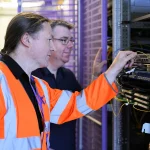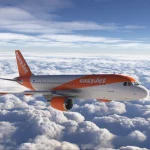BT Successfully Aggregate Four 5G Bands in Standalone Network

Mobile and broadband provider BT (EE) and Nokia claim to have achieved somewhat of a “European first” by aggregate four channels of radio spectrum in a live 5G Standalone (SA) network. In theory, this could make their UK mobile network capable of delivering some exceptionally fast download and upload speeds.
Combining multiple radio bands together to boost data speeds and coverage is nothing new, with Carrier Aggregation (CA) – also known as Carrier Components (CC) – technology being a common feature of 4G networks. The same capability also exists for 5G networks and operators are slowly starting to harness this, often as part of upgrades toward a true end-to-end 5G Standalone (SA) network (these remove any reliance on existing 4G networks).
The impact of this was aptly demonstrated earlier this year (here), after Nokia achieved a new 5G SA download speed record of 2.94Gbps (Gigabits per second) with the first deployment 3 Carrier Components (3CC). This was done by aggregating some 5G FDD spectrum (30MHz from the 700MHz / n28 band) and some 5G TDD spectrum (100 + 60MHz from the 2.6GHz / n41 band).
Advertisement
The latest development goes a step further by adopting 4CC across four low-band and mid-band radio channels (2.1GHz, 2.6GHz, 3.4GHz and 3.6 GHz). The trial was conducted in two stages; it was first performed in BT’s Radio Lab in Bristol, and then moved outdoors, onto a radio mast at BT’s Adastral Park in Suffolk.
“Not only is it the first time in Europe that a network operator has achieved 4CC on 5G SA using commercial spectrum, but it is also the first time it has been achieved outside of a lab in Europe,” said BT’s announcement.
Greg McCall, Managing Director Service Platforms BT, said:
“Our trial with Nokia is another demonstration of building the most advanced network for our customers. 5G Standalone, coupled with edge compute, will unlock new opportunities for customers looking to develop new services. Furthermore, this technology showcases what’s possible for devices in the future in terms of supporting carrier aggregation, which is an important part of customer experience.”
Mark Atkinson, SVP, Radio Access Networks PLM, Nokia, said:
“We are once again delighted to be deepening our partnership with BT, supporting them with our industry-leading Carrier Aggregation technology for this trial. Nokia and BT have a long history in investing in cutting-edge technologies and this trial is another example of what our companies can achieve together.”
All of this represents positive progress, although it’s worth noting that BT and Nokia did not say what kind of mobile broadband speeds they were able to achieve with this trial, or over what distance. On top of that, it will take time to fully deploy 5G SA networks and the UK rollout plan for them is still a little unclear, although operators tend to deploy such things inside the biggest cities first.
Mark is a professional technology writer, IT consultant and computer engineer from Dorset (England), he also founded ISPreview in 1999 and enjoys analysing the latest telecoms and broadband developments. Find me on X (Twitter), Mastodon, Facebook, BlueSky, Threads.net and Linkedin.
« UK ISP Sky Broadband Adds Free Wall to Wall WiFi Guarantee UPDATE






















































Would someone please be able to elucidate those of us about why supposedly doesn’t have ‘proper’ 5G? (If that is in-fact the case).
One reason is because Non-Standalone (NSA) makes 5G technology easier to deploy as you can harness existing 4G infrastructure for deployment and cut the time + costs required to get the network operational. In other words, it’s common because NSA is a transitional technology before SA.
NSA also helps to boost the range of 5G as masts can broadcast much further range than your phone with limited power and a tiny antenna so utilising 4G for uplink at much lower frequencies allows you to stay connected until more 5G sites infill the coverage gap.
hopefully us British people here in uk will get mmwave 5g in future.
Fat chance. We barely get a working 4G signal in most places.
Work in progress.
https://www.ispreview.co.uk/index.php/2022/05/ofcom-consult-on-opening-24ghz-and-40ghz-bands-to-5g-mobile.html
Maybe 2030. We are very slow and behind on 5g comparing USA
mmwave is useless to use what we really need is C-Band which is in working progress. It’s far better to have Sub-6 at the moment but C-Band is what we really need. However seeing CA progress is a big deal for us!
i dont see point ,,,,,the only machines that can handle this speed are gaming PCs ,and even then the latency will be so bad theres on point , all this does is help fredd download lord of the rings 25gig blue ray faster
Ironically, all I really want is carrier aggregation on 700Mhz, 800Mhz and 1800Mhz spectrum. In rural areas this would revolutionise download speeds, and heck, apart from definitions they are basically 4G technologies (if I understand correctly).
By the time this is rolled out itll be 2060. We are still told to switch to 3G because 4G coverage isnt available. (Try switching to 3G with the latest iphones 😉
UK is truly world beating 🙂
Problem with coverage we don’t have tall masts. Unfortunately we don’t have many tall building in residential area mainly on country side and villages.
Three uk have applied to local authorities to build 20 meters masts and refused because of stupid public. They don’t want to see tall mast outside of their houses and they still want decent coverage.
We need 3 operators not 4. That mean each operators get decent amount of spectrum like most EU countries.
Also operators not using 700mhz spectrum properly.
In 2019 had a week in Porto, had fantastic 4G (navigating with Google maps was a dream). Most of the buildings were old and of 5-8 floors high, could not see any cellsites or masts, wondered how this coverage was achieved